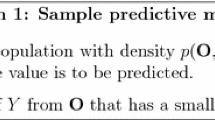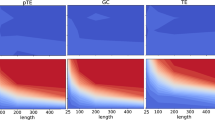Abstract
The validation of causal relationship between two groups of multivariate time series data often requires the precedence knowledge of all variables. However, in practice one finds that some variables may be negligible in describing the underlying causal structure. In this article we provide an explicit definition of “non-informative variables” in a two-group causal relationship and introduce various automatic computer-search algorithms that can be utilized to extract informative variables based on a hypothesis testing procedure. The result allows us to represent a simplified causal relationship by using minimum possible information on two groups of variables.

Similar content being viewed by others
References
Arnold A, Liu Y, Abe N (2007) Temporal causal modeling with graphical Granger methods. In: Proceedings of the 13th ACM SIGKDD international conference on knowledge discovery and data mining, pp 66–75
Boudjellaba H, Dufour JN, Roy R (1992) Testing causality between two vectors in multivariate autoregressive moving average models. J Am Stat Assoc 87:1082–1090
Dufour JM, Renault E (1998) Short-run and long-run causality in time series theory. Econometrica 66: 1099–1125
Fujita A, Sato JR, Garay-Malpartida HM, Morettin PA, Sogayar MC, Ferreira CE (2007) Time-varying modeling of gene expression regulatory networks using the wavelet dynamic vector autoregressive method. Bioinformatics 23:1623–1630
Geweke J (1982) Measurement of linear dependence and feedback between multiple time series. J Am Stat Assoc 77:304–313
Geweke J (1984) Inference and causality in economic time series. In: Griliches Z, Intriligator MM (eds) Handbook of econometrics, vol 2. North-Holland, Amsterdam, pp 1101–1144
Granger CWJ (1969) Investigating causal relations by econometric models and cross-spectral methods. Econometrica 37:424–438
Granger CWJ (1980) Testing for causality: a personal viewpoint. J Econ Dyn Control 2:329–352
Granger CWJ, Lin JL (1995) Causality in the long run. Econ Theory 11:530–536
Hacker RS, Hatemi JA (2006) Tests for causality between integrated variables using asymptotic and bootstrap distributions: theory and application. Appl Econ 38:1489–1500
Haufe S, Müller K-R, Nolte G, Krämer N (2010) Sparse causal discovery in multivariate time series. In: NIPS 2008 workshop on causality. JMLR workshop and conference proceedings, vol 6, pp 97–106
Hsiao C (1982) Autoregressive modeling and causal ordering of econometric variables. J Econ Dyn Control 4:243–259
Koster JTA (1996) Markov properties of nonrecursive causal models. Ann Stat 24:2148–2177
Koster JTA (1999) On the validity of the Markov interpretation of path diagrams of Gaussian structural equations systems with correlated errors. Scand J Stat 26:413–431
Kutner MH, Nachtsheim CJ, Neter J (2008) Applied linear regression models, 4th edn. McGraw Hill, New York
Lauritzen SL (1996) Graphical models. Oxford University Press, Oxford
Lauritzen SL (2000) Causal inference from graphical models. In: Barndorff-Nielsen E, Cox DR, Klüppelberg C (eds) Complex stochastic systems. CRC Press, London
Lütkepohl H (2005) New introduction to multiple time series analysis, 1st edn. 2nd printing, Springer, Berlin
Lütkepohl H, Burda MM (1997) Modified Wald tests under nonregular conditions. J Econ 78:315–332
Makridakis SG, Wheelwright SC, McGee VE (1983) Forecasting: methods and applications. Wiley, New York
Mosconi R, Giannine C (1992) Non-causality in cointegrated system: representation. Estimation and testing. Oxf Bull Econ Stat 54:399–417
Osborn DR (1984) Causality testing and its implication for dynamic econometric models. Econ J 94:82–96
Pearl J (1995) Causal diagrams for empirical research (with discussion). Biometrika 82:669–710
Pearl J (2000) Causality: models, reasoning, and inference. Cambridge University Press, Cambridge
Roebroech A, Formisano E, Goebel R (2005) Mapping directed influence over the brain using Granger causality and fMRI. NeuroImage 25:230–242
Whittaker J (1990) Graphical models in applied multivariate statistics. Wiley, Chichester
Author information
Authors and Affiliations
Corresponding author
Rights and permissions
About this article
Cite this article
Hung, YC., Tseng, NF. Extracting informative variables in the validation of two-group causal relationship. Comput Stat 28, 1151–1167 (2013). https://doi.org/10.1007/s00180-012-0351-z
Received:
Accepted:
Published:
Issue Date:
DOI: https://doi.org/10.1007/s00180-012-0351-z




